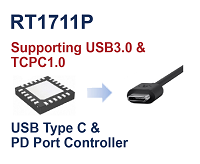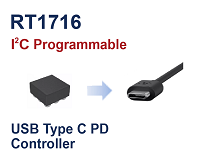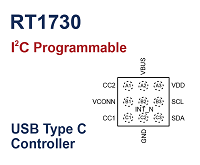 |
|
Introducing Richtek USB Type-C Power Delivery Solutions |
|
The USB Type-C standard has been developed to meet the ever
growing needs of connectivity between modern devices. The latest
USB Type-C Power Delivery (PD) standard provides significantly
more power and higher data transfer speed. As a member of the
USB Implementers Forum (USB-IF), Richtek has been developing
innovative USB Type-C and PD compliant products to meet the
latest standard for a wide range of applications, from USB-PD
power adapters, Car Chargers, Type-C cable e-Mark ICs to Type-C
Dual Role Power PD port controllers which use the latest USB3.0
PD protocol to support Direct Charging systems. This issue will
introduce the basic operation of USB Type-C systems with Power
Delivery, and show some practical examples of USB Type-C applications
with selected Richtek USB Type-C power management solutions. |
- What is USB Type-C? This is
a new 24-pin USB connector system allowing higher
power transfer and faster data transfer than previous
USB standards. Please see the
comparison tables between the older USB and
new Type-C Standard in terms of connectors, connections,
data speed and power.
|

|
|
- Key advantages of new USB Type-C standard:
Reversible plug orientation, smaller physical connector
and receptacle size, auto-configuration, dual role capability
for both data and power, up to 100W (20V/5A) of power transfer
with PD; up to + 10Gbps data rate and support for Alternate
Mode data transfer like HDMI / DisplayPort / Thunderbolt.
.png)

|
- How does USB Type-C configure data and power?
Because the Type-C plug is reversible and identical
for both cable ends, the USB type-C system includes Configuration
Channel (CC) logic which takes care of sensing and communication
functions:
- Sensing of Device connection and Host current capability
- CC PD communication between host and device to allow selection
of the suitable bus voltage and current
- detection of the connection polarity in order to configure
the transceiver to select the correct wire pairs for data
transfer.
 Read more to learn about the system block diagrams and
view examples waveforms of the basic USB Type-C Source to
Sink connection without and with Power Delivery.
Read more to learn about the system block diagrams and
view examples waveforms of the basic USB Type-C Source to
Sink connection without and with Power Delivery.
|
- Under what condition is an E-marker IC required
in a Type-C cable? Cables that support Superspeed
USB3.1 data transfer or cables that can carry currents higher
than 3A must be electronically marked, to inform the Host
about cable characteristics like current capability, the
presence of re-driver for signal conditioning, etc. The
presence of an e-marked cable is detected by the CC logic
which then connects VCONN power to the cable electronics.
Read more to regarding Richtek E-marker IC solution
RT1710 and its evaluation board and test tools.
|
|
Richtek USB Type-C PD Power Solutions |
|
Richtek provides evaluation kits and development boards for
various USB Type-C Power Delivery applications. |

|
|
For USB Type-C Power Adapter with Power Delivery applications,
we have developed
RT7786 wide range Flyback controller which works together
with
RT7207 USB Type-C PD controller with Synchronous rectifier
at secondary side to form a total adapter solution with high
efficiency covering the complete Power Delivery range. |

|
|
Applications like Smart-Phone, Tablet PC or Notebook PC can
sometimes act as host (Power Source) and sometimes become power
consumer (Sink) when they are charged. In this case a Dual Role
Power (DRP) port controller is needed.
RT1715 is a tiny 1.38x1.38mm USB Type-C controller including
CC logic, PD3.0 communication, VCONN support and role swap with
I2C bus.
RT1711P is a full-featured USB Type-C PD controller and
includes power path control, VBUS current sense, VBUS discharge
and DC/DC converter output control. |
|
USB Type-C car charger applications with Power Delivery will
need a Buck-boost regulator to derive the 5V - 20V VBUS voltage
from the 13.5V car battery. RTQ7880 is an automotive grade USB
Type-C PD Source solution with integrated Buck-Boost controller
for delivering up to 100W for charging Mobile phone, Tablet
PC and Notebook PC in your car. It includes an embedded ARM
CortexTM-M0 MCU for high flexibility, including programmable
cable drop compensation and protection features, VCONN support,
customizable GPIO’s and master & slave I2C
bus. For more USB Type-C PD reference designs in car charger
applications please read more
here. |

|
|
For more information, Please read the full application note ‘‘Introduction
to Richtek USB Type-C Power Delivery Solutions’’.
You can also find Richtek USB PD solution on the
application page and the list of USB PD products on the
product page. If you would like to have more information
on the USB Type-C PD design kits, please contact
your nearest Richtek sales office. |
|
New Products |
 |
RT1711P is a USB Type-C and Power Delivery
(PD) Port Controller in a WQFN-24L 3.5x3.5 package.
Supporting USB PD3.0 and TCPC1.0, RT1711P integrates
a complete Type-C transceiver providing cable
recognition and orientation detection. It also
integrates the physical layer of the USB BMC
power delivery protocol, allowing up to100W
of power transfer and role swap. Ideal for portable
devices, monitors, TVs, power bank, etc.
⇒
Get Free RT1711P Sample Now |
 |
RT1716 is a programmable USB Type-C PD Controller
in a WL-CSP-8B 1.38x1.34 package. Supporting
PD 3.0 except fast role swap function, RT1716
is dual-role PD compatible providing attach/detach
detection and orientation. It provides the physical
layer functionality of the USB-PD protocol suitable
for portable devices. |
 |
RT1730 is a programmable USB type-C Controller
in a WL-CSP-9B 1.38x1.34 (BSC) package.
With similar features to RT1716, RT1730
has an extra regulated input VCONN pin to power
the IC within an electronically marked Type-C
cable.
⇒
Get Free RT1730 Sample Now |
|
|
|